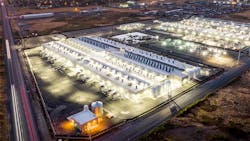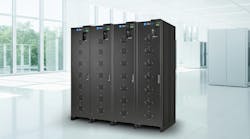AWS Eyes New Strategies to Meet Energy Goals for its $15 Billion Oregon Cloud Region
Amazon Web Services says it has invested $15 billion in its cloud cluster in Oregon, which has become the primary West Coast deployment zone for the AWS cloud platform. The company is continuing to expand in Oregon, with plans to build more data centers in Morrow County and billions of dollars of additional investment.
As it grows, the huge cloud platform is pursuing new strategies to procure power with the necessary scale and sustainability. Amazon recently crafted an agreement with an Oregon utility that will allow the company to ramp up its purchases of renewable energy, and is adding on-site energy generation to several of its new data centers in the region.
Amazon has become the world's largest corporate buyer of renewable energy, purchasing massive amounts of wind and solar energy. These deals have placed Amazon on a path to powering its operations with 100% renewable energy by 2025, five years ahead of its original commitment in 2019.
But as the cloud grows faster than the grid, data center operators are grappling with how to translate their climate goals into real-world electrons on local grids. Amazon's sustainability goals can only be achieved by navigating the complexities of the U.S. power grid, which is struggling to bring enough renewable energy online to meet the needs of its largest customers.
Those tensions generated headlines recently as Amazon took heat for its opposition to an Oregon bill seeking to limit greenhouse gas emissions from data centers and cryptocurrency operations. The optics were tough for Amazon, whose lobbying seemed inconsistent with its public Climate Pledge. AWS says its stance reflects the need for a broader policy approach that fully includes both utilities and data centers.
In the meantime, several of Amazon's new data centers in Oregon will be supported by on-site power generation from fuel cells running on natural gas. AWS describes the decision as a short-term strategy to support customers in its US-West region until its renewable energy agreement ramps up, enabling larger procurements of wind and solar power.
A Cloud That Spans the Globe
Amazon Web Services is supported by a massive deployment of digital infrastructure, including data center campuses, edge content zones, and subsea cables. One of its largest investments is in Oregon, home to the US-West region for AWS, which includes four Availability Zones (AZs). That makes US-West the second-largest cluster of AWS data centers, trailing only the US-East Northern Virginia Region, which includes 6 AZs and about 50 data centers, representing $35 billion in investment. The company has a large cloud region in Ohio, where it has built a cluster of data centers to create 3 availability zones.
AWS also operates Local Zones to provide edge computing capacity in 16 locations across the U.S., as well as edge infrastructure in regional data center hubs around the country.
Cloud computing is a major player in the shift to renewable energy to power the Internet economy, with AWS, Google, Facebook, Amazon, Microsoft and Apple making commitments to power their cloud data centers with renewable energy. These companies purchase wind and solar energy to offset their data center energy use, usually by adding renewable energy to the same grid its data centers are using.
Over the past three years, Amazon has bought more than 20 gigawatts of renewable energy in more than 400 projects in 22 countries. In 2022, Amazon increased its renewable energy capacity by 8.3 gigawatts, which it says is a new corporate record for single-year renewable purchasing. The company has been the largest corporate buyer of renewables since 2020, according to Bloomberg New Energy Finance.
A number of those power purchases have supported the Western Interconnect, the regional grid that includes Oregon. As a result, AWS says its US-West region is powered with 95% renewable energy.
AWS has also invested in infrastructure that enables up to 96% of the water used in its data center cooling operations to be reused for irrigation. AWS sends the spent water through a separate piping system into canals that provide irrigation water for local farmers. Here's a video overview:
Data Center Emissions at Issue in Oregon Bill
Procuring power to support the rapid growth of cloud computing is growing complicated, as seen in the recent policy debate in Oregon.
In 2021, Oregon passed the Clean Energy Targets Bill, which was hailed as one of the most ambitious state efforts to reduce carbon dioxide emissions from its power grid. The law requires utilities Portland General Electric, PacifiCorp and Electricity Service Suppliers to reduce their greenhouse gas emissions to 80 percent below baseline emissions levels by 2030.
Earlier this year Oregon bill HB 2816 sought to set similar targets for data centers and cryptocurrency facilities with power capacity of 10 megawatts or more, requiring them to reduce greenhouse gas emissions to 60 percent below "baseline emissions levels" by 2025 and 80 percent by 2030. The consequences would be steep: HB 2816 sought to impose daily fines of $12,000 per megawatt hour on any operator that fails to meet the goals.
The bill was widely supported by Oregon environmental groups and non-profits. "These facilities represent some of the most energy intensive users in the state and should be included in accountability for Oregon’s climate goals," wrote the Oregon Sierra Club.
Although the bill met resistance from business groups and communities housing data centers, media coverage focused primarily on Amazon. Although no major data center companies publicly commented on the bill, The Oregonian reported that Amazon was lobbying against the measure behind the scenes, and contrasted that effort with the company's public position. The CNBC and the Washington Post followed up with similar stories.
Amazon says the bill took a targeted approach when a holistic solution was needed.
"A number of organizations, including Amazon, oppose HB2816 because the bill does not address the build-out of electric infrastructure that is needed to bring more clean energy to the grid," an AWS spokesperson said in a statement to DCF. "Building new renewable projects requires infrastructure investments in the grid and today there are hurdles in key areas like permitting and interconnection.
"Accelerating energy infrastructure permitting and interconnections for renewables like solar and wind would have a greater impact on reducing emissions, bringing more clean energy to the grid, and helping achieve our goal of accessing more clean energy in Oregon," AWS added. "We look forward to working with the State, industry, and community leaders to better enable renewable energy development in Oregon.”
The bill also was opposed by technology trade groups and local officials.
"While we appreciate the intent of the underlying bill, we are concerned that this bill unfairly targets data centers located in Eastern Oregon and harms the communities in which they reside," Skip Newberry, President & CEO of the Technology Association of Oregon, told legislators. "Oregon tech companies do not control the decisions that their energy utilities make. They alone cannot change the structural barriers that prevent more clean energy from powering the grid. Yet this bill penalizes tech companies for decisions outside of their control."
"If passed, this bill has the potential to seriously hinder economic development in Oregon," wrote Paul Beebe, the Mayor of Prineville, which is home to data center campuses for Meta and Apple.
A Greener Future for Umatilla
Amazon cites its recent work with the Umatilla Electric Cooperative (UEC), which serves AWS operations in Umatilla and Morrow Counties, as a sign of progress. AWS doesn't disclose its data center footprint, but it appears to include multiple campuses in Boardman, and several more in Umatilla/Hermiston, totaling about 20 data centers in all.
When AWS began building in the area in 2011, UEC had substantial renewable hydro-electric power available. By about 2017, energy demand at UEC grew beyond the utility's hydro power allocation, and it began buying power on the wholesale market, where the most affordable power was sourced from fossil fuel.
Since that doesn’t meet AWS’ criteria, the new agreement lets UEC continue to buy whatever power it likes for its residential customers while allowing AWS to make greener choices.
"The agreement allows Amazon to take on the responsibility of selecting the energy supply that powers its data center operations, including from renewable energy resources," said an AWS spokesperson. "UEC continues to be an essential partner and provider of reliable utility service to AWS data centers in UEC's service territory."
"We’re now able to directly invest in renewable energy across the Pacific Northwest to help power AWS operations in Oregon," said Charley Daitch, director of Energy and Water at AWS, in a blog post . "We’re grateful for the collaboration with UEC, which will help us stay on a path to meeting 100% renewable energy by 2025."
On-Site Generation Will Bridge a Local Power Gap
It will take some time to ramp up the renewable purchasing through the UEC agreement. In the interim, AWS is continuing to expand its data center operations, including some projects that will use on-site power generation from fuel cells using natural gas. AWS has submitted permits for fuel cells in three locations, which will support some (but not all) of the electric load of the data centers.
“We are investing in fuel cells as a way to power a small number of our operations in Oregon," said an AWS spokesperson. "We continually innovate to minimize our impact on our neighbors, local resources, and the environment and this technology provides a pathway for less carbon intensive solutions in the region."
Amazon is clear that it sees fuel cells as an interim solution to support its operations until the completion of transmission and distribution upgrades in the region.
Other data centers are pursuing similar strategies in other markets. Eleven data centers have received permission to be connected to a Gas Networks Ireland (GNI) pipeline in Dublin, where electric utility EirGrid has halted new power hookups for data center projects.
This is consistent with DCF's 2023 Forecast, which cited "bring your own power" as a key trend. "In 2023 we will see more data center projects that include on-site energy generation to enable expansion in grid-constrained markets," we wrote.
The downside is that natural gas is sourced from fossil fuels that contribute to climate change. But data center operators hope to be able to shift from natural gas to sustainable fuels like hydrogen. Amazon is working with Plug Power to use green hydrogen in factory equipment and forklifts, and says it is working on hydrogen solutions for "fuel cell power generation stations supplying electricity to Amazon buildings."
About the Author



